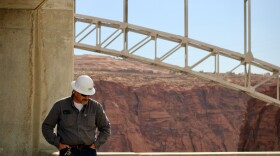An extra pulse of water has been sent through the Grand Canyon this week. The Bureau of Reclamation is running a “high-flow experiment” at Glen Canyon Dam in northern Arizona, which means a big release of water designed to move and redeposit sand and sediment will make its way downstream from the dam. This experiment is the first since 2018, and comes in response to forecasts for an above average spring snowmelt in the Rocky Mountains.
Sediment carried and moved by high flows helps to rebuild beaches and sandbars, which provide habitat for wildlife in the Grand Canyon. The restored beaches are also important for ensuring enough campsites exist for the canyon’s many rafters and boaters.
The extra water comes from Lake Powell, the nation’s second-largest reservoir. Before the Colorado River was dammed to create the reservoir, snowmelt from the Rocky Mountains would often cause a natural surge of sediment-laden water each spring.
Some video of the Glen Canyon Dam high flow experiment that simulates flooding through the Grand Canyon.
— Bureau of Reclamation (@usbr)
“The ecosystem is generally familiar with having a big spring flood,” said Sinjin Eberle, Southwest Communications Director at the conservation group American Rivers. “It snows all winter, that snow runs off, you have big floods. With that natural cycle being cut off, we've had to try to simulate these big high floods.”
Eberle’s organization recently named the Grand Canyon section of the Colorado River as the nation’s “most endangered” river, partially due to the lack of recent high-flow experiments there. American Rivers receives funding from the Walton Family Foundation, which also funds a portion of ������Ů's Colorado River coverage.
“It certainly is a sigh of relief,” Eberle said. “Especially because the damage to the canyon over the last couple of years has been pretty dramatic.”
This spring’s high-flow experiment is being carried out over 72 hours from April 24 through April 27. Water releases from Glen Canyon Dam were planned to be as high as 39,500 cubic feet per second during the experiment. April releases from the dam without high-flow experiments are typically between 8,000 and 15,000 cubic feet per second.
Flow data comes from the Bureau of Reclamation, the federal agency which manages water in the West. Reclamation officials declined to be interviewed for this story.
Record snowfall in the Rocky Mountains has bred optimism about the amount of water added to the Colorado River this year. About two-thirds of the river begins as snow in the state of Colorado, where snow totals this year have surpassed 150% of the long-term average.
As a result, summer inflows at Lake Powell are projected to be 177% of average, a forecast which triggered the decision to run a high-flow experiment this year.

The high-flow experiment began before much of that snowmelt entered Lake Powell, though. John Rickenbach, an environmental consultant with on Lake Powell and the Colorado River, said the experiment could have been carried out a few weeks later, when more snowmelt had melted into the river, “just to be safe.”
“All they're really doing is concentrating the flow—that otherwise would have occurred a little more spread out—into a smaller period of time,” Rickenbach said. “If they were going to do that early in April that could have caused a difficulty for launching boats, but because they did it late in April, that was a big help.”
Dropping water levels at Powell's marinas have threatened to halt operations by stranding boat ramps above the water line.
Despite this year’s strong snowfall and flows, trouble still lingers for Lake Powell and the Colorado River. The reservoir's water levels hit a new record low this spring. Climate change has fueled 23 years of dry conditions and water managers who decide how the river is shared have struggled to agree on significant cutbacks to water use. That supply-demand imbalance means it would take more than one snowy year to substantially fix the Colorado River crisis.
“It's great to see a big snowpack,” climate scientist Brad Udall told ������Ů in January. “We would need five or six years at 150% snowpack to refill these reservoirs, and that is extremely unlikely.”
This story is part of ongoing coverage of the Colorado River, produced by ������٠in Colorado and supported by the Walton Family Foundation. ������٠is solely responsible for its editorial coverage.




